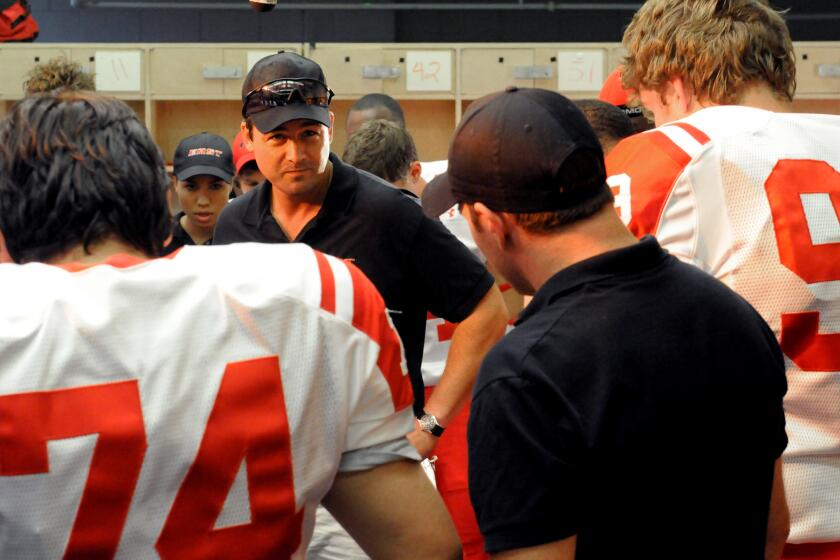Fred Friendly, Pioneering Television Journalist, Dies
Fred W. Friendly, the seminal broadcast journalist who as television’s wunderkind created the innovative “See It Now” and as its eminence grise campaigned relentlessly against commercialization of the medium, has died. He was 82.
Friendly, who boldly resigned as CBS News president to protest the preempting of a Senate debate on the Vietnam War by an “I Love Lucy” rerun, became known to a newer generation of viewers when he organized the PBS’ series “Media and Society Seminars.”
He died Tuesday at his New York home after a series of strokes, CBS announced Wednesday.
For about 55 years, Friendly sought by example and vociferous commentary to use the permeating power of television to enlighten the public. From “See It Now,” which he started with the late, legendary Edward R. Murrow in 1951, to “CBS Reports,” where he won 10 Peabodys and 30 other awards from 1959 to 1964, to the PBS series he created in 1983, Friendly never failed to make television history.
“This little black box didn’t get invented at this time in our technological evolution just to show pictures of horse operas,” Friendly once said. “It is just asking to be used. We can take the people there and show them what is happening.”
The PBS seminars were renamed in Friendly’s honor after he stepped down from what he called “America’s largest classroom” in 1992, using the words that Murrow had said to him decades earlier: “Nothing is forever.”
PBS President Ervin S. Duggan on Wednesday called Friendly “a great broadcaster, a great innovator, a great friend of public television. Most of all, he was a good citizen, deeply committed to the ideals of serious civil discourse and an informed populace. . . . We in public broadcasting are proud to be part of his monument.”
Friendly never missed an opportunity to critique the changing focus of his industry.
“Television has lost its ethical compass,” he told The Times in 1992 after reiterating on his final PBS broadcast his belief in “our most essential agenda: not to make up anybody’s minds; to make the agony of decision-making so intense you can escape only by thinking.”
“That’s what it’s all about,” he said. “Television has lost its ability to figure out what television is there for.”
Introduced to Murrow in 1948, Friendly first collaborated with him on record albums featuring Murrow’s incisive commentary coupled with the famous voices of modern history in the now legendary series “I Can Hear It Now.”
After a short-lived radio program of the same name, Friendly and Murrow began co-producing television’s “See It Now” in 1951.
The weekly news program featuring Murrow on camera and Friendly as the producer took viewers to Europe for a ride on the Orient Express, to Korea for a battlefield tour, and to Ann Arbor, Mich., for the announcement of Dr. Jonas Salk’s new polio vaccine.
But the show and its creators earned their niche in history on March 6, 1954, with their “Report on Senator McCarthy,” an examination of Sen. Joseph R. McCarthy and his redbaiting tactics. The single program prompted more than 100,000 mostly favorable viewer responses to CBS, and signaled what some critics called “television’s coming of age.”
It was broadcast at a time when the Republican senator from Wisconsin had bullied the most powerful politicians in the land into silence for fear that they might be attacked as part of a “Communist conspiracy.” The Murrow-Friendly broadcast was the first nationwide overt attack on McCarthy and was credited by many with his ultimate censure by the Senate.
With CBS too timid to advertise the upcoming McCarthy program, Friendly paid for a newspaper ad out of his own pocket, colleague Daniel Schorr recalled Wednesday in his commentary on National Public Radio.
At the end of its seven-year run, “See It Now” was ignobly shifted to obscure hours and finally was canceled in 1958. The show fell victim to the commercialism that Friendly battled throughout his career--the networks’ preference for more marketable adventure and game shows over controversial documentaries.
On his own, Friendly continued producing quality shows for his hard-hitting “CBS Reports,” which became the most honored show on television in its day. He prodded correspondents like Schorr into doing the impossible, such as asking East Germany to permit filming of a documentary about “the land beyond the Wall.” Friendly got his wish and made history in that period decades before the Berlin Wall tumbled.
In 1964, Friendly reluctantly abandoned running that show--what he called “the best job in the world,”--to become chief of CBS News.
“I feel like I’ve been shot into orbit and have no retrorockets to come down with,” he joked. “If this isn’t fun, I’ll be a flop.”
Friendly was certainly no flop, but he didn’t have much fun either. And on Feb. 15, 1966, he dramatically resigned when network executives canceled his planned live coverage of the Senate Foreign Relations Committee’s public hearings on the Vietnam War. Instead, viewers were treated to a far more marketable rerun of “I Love Lucy.”
“I am resigning,” he said in a stinging and widely published letter, “because the decision not to carry the hearings makes a mockery of the [CBS Chairman William S.] Paley-[CBS President Frank] Stanton Columbia News division crusade of many years that demands broadest access to congressional debate.”
In his 1967 book, “Due to Circumstances Beyond Our Control,” Friendly blamed the programming decision not on individual executives but on “the mercantile advertising system that controls television.”
Friendly immediately became communications advisor to the Ford Foundation, and the driving force behind foundation efforts to fund public television. He was credited with prodding Congress into chartering the Corporation for Public Broadcasting, and remained an irascible critic of what he saw as network pandering for profits.
He also became, appropriately, the Edward R. Murrow professor of journalism at Columbia University.
Ferdinand Friendly Wachenheimer was born in New York City, the only child of jewelry manufacturer Samuel Wachenheimer and the former Therese Friendly. He grew up in Providence, R.I., and studied business administration at Nichols Junior College in Dudley, Mass.
Hired by radio station WEAN in Providence in 1937, the young announcer shortened his name to Fred Friendly at his employer’s insistence. Along with announcing duties, he wrote, produced and narrated a biography series on such historical figures as industrialist Harvey Firestone and inventor Thomas Edison, called “Footprints in the Sands of Time.” Later reproduced on record, the series paid Friendly $8 a show.
Enlisting in the Army during World War II, Friendly was an instructor in the Signal Corps in Europe and the Pacific, and a correspondent for the military publication CBI Roundup, earning the Legion of Merit and four battle stars. Shortly after his discharge, when he was working as a CBS correspondent in Bombay, India, he won the Soldier’s Medal for helping to rescue survivors of a dock explosion.
Friendly returned to radio with a panel quiz show, “Who Said That?” which he co-produced with his first wife, Dorothy Greene, for NBC.
After the show’s cancellation, he met Murrow. Together they segued into television to test the new medium’s possibilities.
The two men, as Eric F. Goldman noted in the New York World Journal Tribune in 1967, “had the same fire in their bellies--a fire made up of all kinds of elements but including that age-old American emotion which insists that when something new comes along, it should be used to help the ordinary American become less ordinary.”
Schorr recalled Friendly on Wednesday as simply “the other half of Ed Murrow.”
Their “See It Now” garnered 35 major awards, including the National Headliners Club award and the Overseas Press Club award.
After the show’s cancellation, the two co-produced another quality weekly public affairs program called “Small World,” which lasted only a year.
Friendly, although outspoken, rankled CBS executives less than the highly independent Murrow. When Stanton asked Friendly to become executive producer of “CBS Reports” in 1959, Murrow was clearly excluded.
After Friendly’s stormy exit from network television, he became a popular lecturer and author as well as a teacher, thumping for 1st Amendment press freedom and flagellating television for sacrificing ideals for money.
Friendly wrote five books, among them, “See It Now” with Murrow in 1955, “The Good Guys, the Bad Guys and the First Amendment: Free Speech vs. Fairness in Broadcasting” in 1976, and his most popular, “Minnesota Rag” in 1981.
The last, bringing home to the general public the importance of 1st Amendment freedoms, detailed the true story of a radical and racial bigot, Jay M. Near, who owned a weekly newspaper or “rag” called the Saturday Press. The paper had been shut down under Minnesota’s Public Nuisance Act for its articles on local government corruption. Near sued the state and won the landmark 1931 ruling from the U.S. Supreme Court known as Near vs. Minnesota, which forbids prior restraint of a publication.
Friendly proved (even to his own surprise) that, unsavory as Near was, the charges of local government corruption that he had printed were true. Friendly’s book underscored what he advocated for a lifetime--that the news media must remain free from government censorship, for even unsavory bigots can reveal truths useful to a democracy.
In 1994, Friendly was inducted into the Television Academy Hall of Fame. The same year he received the Alfred I. duPont-Columbia University Award for outstanding broadcast journalism for serving as “catalyst and conscience for the highest standards of excellence and public service in all media.”
Friendly and Greene, who later divorced, had three children, Andrew, Lisa and David. In 1968, Friendly married a retired teacher, Ruth W. Mark, who survives.
The complete guide to home viewing
Get Screen Gab for everything about the TV shows and streaming movies everyone’s talking about.
You may occasionally receive promotional content from the Los Angeles Times.



